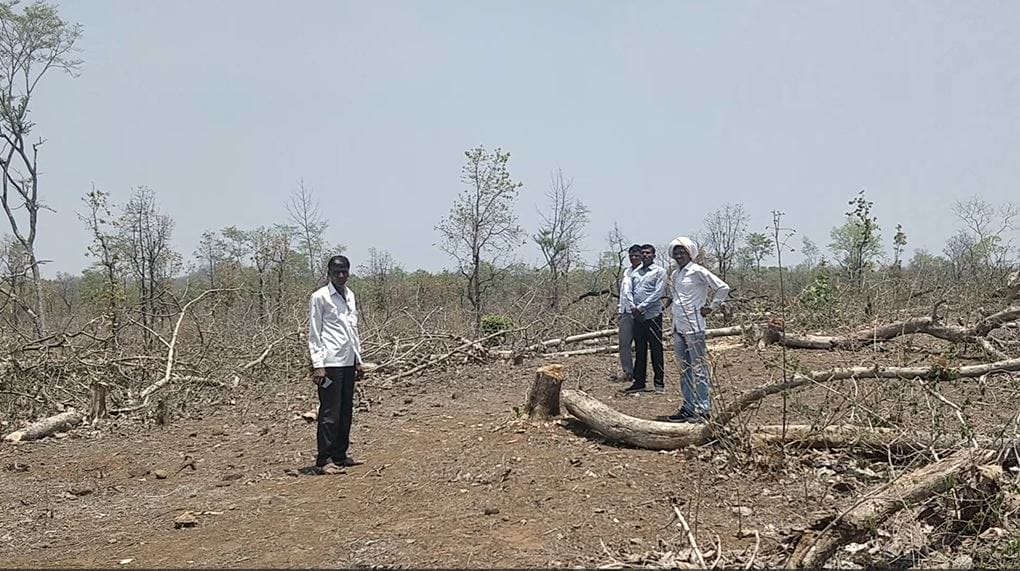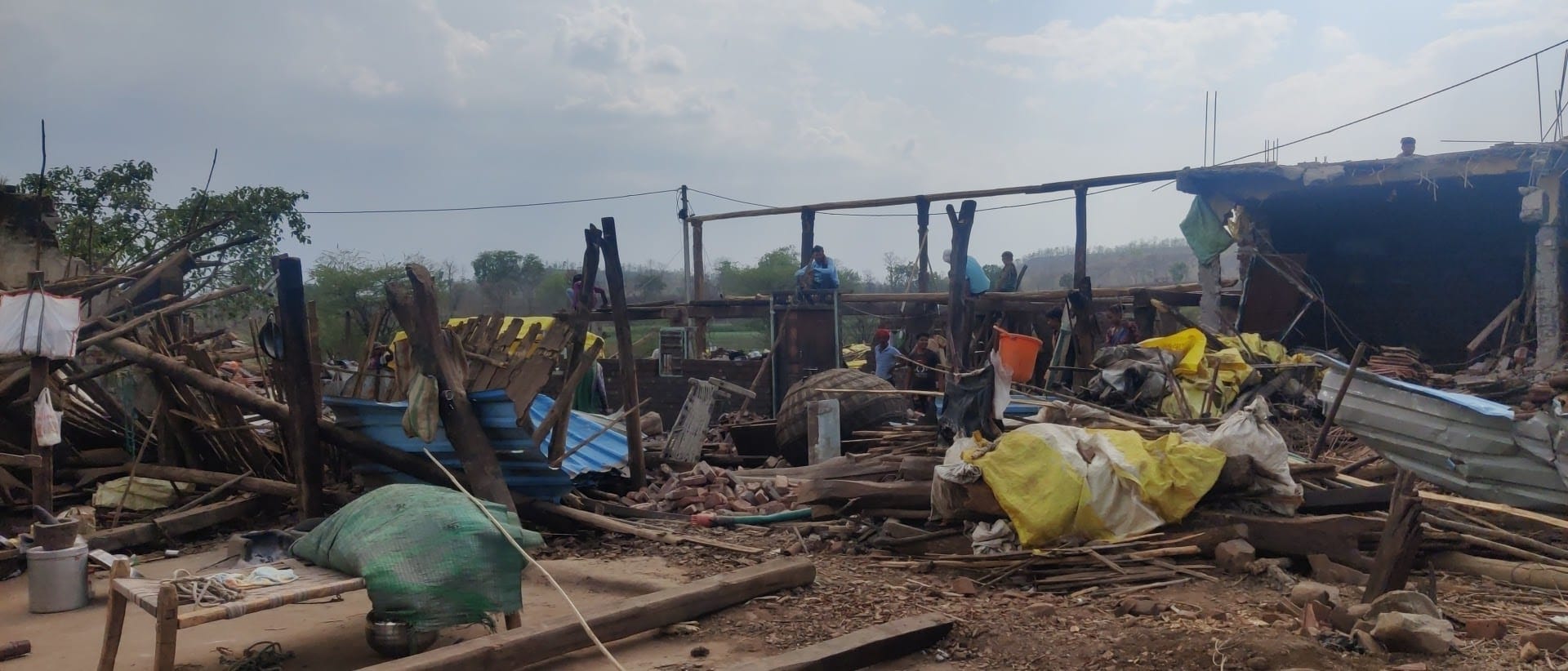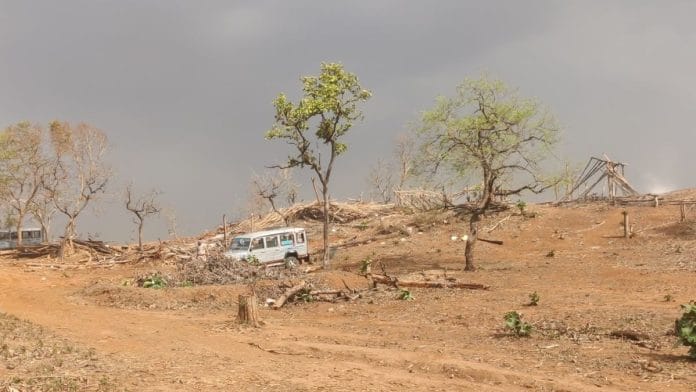Six hundred policemen descended on Bakhari village in the forest of Madhya Pradesh’s Nepanagar in April. They came in camouflaged cars, vans and buses with iron-grilled windows. Bulldozers rumbled in their midst and drones hovered above. From various hillocks, around 800 people—most were Bhilala and Barela tribals—armed with bows, arrows, stones and slingshots, watched them approach.
The officers were responding to an incident involving a group of tribals ransacking a police station in April to free a local land mafia leader.
The push and pull between jungle and zameen—conservation goals and people’s right to land—began with the Forest Conservation Act 1980, but couldn’t be resolved by the Forest Rights Act 2006. Now it is playing out in full force in the latest battle for fertile forest land in Burhanpur, bordering Maharashtra.
Nepanagar is a divided land. Poor Bhilala tribals fighting for farmland are crossing swords with wealthier Korku and OBC farmers who want to protect what’s left of the forests in the Naavra range. Land rights activists from outside the state are pitted against local green activists, while senior Indian Police Service (IPS) and India Forest Service (IFS) officials engage in a blame game. Three district forest officers have been transferred, with two of them serving for less than a couple of months.
In 17 days of police operations, Bakhari village was razed to the ground for alleged encroachment and large-scale deforestation. FIRs were registered, around a thousand homes were flattened, and 260 people were arrested.
“We were forced out of our ancestral land, and are only reclaiming what was always ours,” says a villager from Bakhari, who did not want to be named.
The Forest Rights Act (FRA) 2006 recognises the rights of forest-dwelling tribal communities and traditional forest dwellers. And it has given impetus to their fight. But most of the land claims have not been settled. Similar conflicts are playing out across India such as in Khammam district in Telangana and Mhadei wildlife sanctuary in Goa.
The Indian government has settled only around 50 per cent of claims made under the FRA by June 2022, according to data released by the Ministry of Tribal Affairs in 2022. In Burhanpur, more than 5,600 claims under the FRA are still “under process”.
As a result of the delay, tribals who are rightfully entitled to the land remain landless, and the rate of deforestation suggests systemic mass felling of trees.
“We’re in a medieval war against the forest mafia,” says Burhanpur’s divisional forest officer (DFO) Vijay Singh, expressing his helplessness to resolve two competing claims of the state.
Police claim that the local land mafia wants to massacre the forests to give rise to lush fields that would yield profitable crops. “They want to do it [deforestation] in the name of tribal rights. Encroaching forest land and then applying for land registration under the Forest Rights Act is the modus operandi,” says Burhanpur Superintendent of Police Rahul Lodha.
In the backdrop of this strife and ruin, more than 57,000 hectares of 1.9 lakh hectares of documented forest land have been lost to felling and encroachments over the past five years, according to DFO Singh.
Kishore Chandra Deo, the former minister of tribal affairs and one of the architects of the FRA, blames successive governments for their extreme approach in the jal-jungle-zameen (water-forest-land) conflict.
“Earlier, under the Forest Conservation Act, the contention was to remove everyone. Now it is to give land rights to anyone who asks for them,” he says. “The trees don’t have a vote, so they tend to lose out.”
Also read: Wrestler protest morphs into farmers’, Jat anger against Modi govt. Women not at forefront
IPS vs IFS
In March, a month before Bakhari village was razed, more than 400 tribals symbolically laid down their weapons before the police. It was part of Burhanpur SP Lodha’s diplomacy efforts. They vowed never to cut trees and encroach upon forest land again. But such ‘surrenders’ have not been effective.
Shortly after this pledge of non-violence, a group of Bhilala tribals allegedly ransacked a forest office in Nepanagar and beat up female forest rangers to free their accomplices whom the police had arrested for cutting down trees.
On 11 March, there was a confrontation between the encroachers and tribals from villages like Ghagharla and Siwal. Reportedly 13 forest officials and one villager sustained injuries after the encroachers rained arrows and pelted stones at them.
Simultaneously, another on-paper confrontation ensued. Lodha and then-DFO Anupam Sharma exchanged accusatory letters, pointing out lapses in each other’s response. ThePrint has accessed the letters. Sharma said the police failed to extend help in time. “You removed encroachment on 20 February. But the reality is that it was temporary and the encroachers returned within 17 days. What kind of encroachment removal drive is this that armed encroachers are unafraid of law and order?” the then-DFO wrote. Lodha alleged forest outposts were not adequately staffed. As violence escalated, Sharma was transferred out of Burhanpur on 17 April even as villagers protested against the move.
He had held the post for less than two months. Before him, Grijesh Kumar Barkare had been DFO, but he completed only 20 days in Burhanpur before he was transferred out. His brief tenure was marked by protests from local green activists protesting the forest department’s alleged inefficacy. “We had gheraoed him for an entire day in Ghagharla village,” an activist says.
A source in the forest department described the conflict as a “law and order situation”, and accused the police of not helping. Sharma’s replacement, DFO Singh, expressed similar frustration and helplessness.
“The forest department isn’t equipped to counter attacks like this. We are not allowed to use guns to even fire in the air, while well-trained tribals acquire positions on hilly terrain and fire rocks and arrows at us,” says Singh.
Land and human rights activists have been making this confrontation an even thornier issue for him. “Any time we take strict action on encroachers, armchair activists in Delhi start sending us letters for abusing human rights. They get organisations like NHRC (National Human Rights Commission) to write to us and put a stop to removing encroachers from forest land. Nobody reports or writes in the interest of the forests that die out in this dirty politics,” he says.
India is considered the deadliest place for forest rangers. In Madhya Pradesh, as many as 52 forest officials have been killed on duty since 1961. While encroacher gangs fire arrows and rocks using slings, forest officers have to rely on sticks or lathis.
On the other hand, Lodha, who has held this post for three years, claimed he always “carried the additional burden of forest department duties on his shoulder”. He insisted that the police have been actively involved in bringing the Burhanpur situation under control.
“Since I took charge in 2020, I’ve established contact with the communities in Bakhari village,” he says. “Channels of talks are always open between us and the villagers. Our first approach has to be through diplomacy.”
But on 7 April, Lodha’s diplomacy strategy crumbled as villagers allegedly attacked and ransacked the Nepanagar police station and the police razed Bakhari to the ground two days later.
“For long I tried diplomacy, and avoided using force. But this time it was important to give a message to show who the real baap (authority) here is,” Lodha says.
Also read: This Haryana coach accused a minister of sexual assault. Now her career is in shambles
Rise of the mafia
In Bakhari village, four men have emerged as powerful land mafia lords. They are led by Phul Singh Subla, and are tribal and Dalit young men called Hema Ram Meghwal, Suriya, Rev Singh. The encroachers function like a well-oiled unit. Working in teams, they venture into forest land with hundred villagers, sometimes even with outside help from surrounding districts. Archers with bows and arrows surround an area to intimidate anyone who dares to stop them. Another group starts cutting trees from denser areas—bigger trees first and then smaller ones.
“They work day and night, and come with a lot of manpower. If 100 people from the village come to cut trees, they can clear out five acres of a forest in a day. Informing the administration has been of little help,” says Sanjay Pathare, an activist of Dalit background from Siwal village who is the founding member of Jungle Bachao Samiti, which has been working in Burhanpur for forest conservation for 25 years.

The encroachers erect watch huts made of wood, which they call ‘KGFs’. Four-five families start living on the razed forest land and soon claim ownership of it.
“They put up school boards in forest land that they raze, so if forest officials even try to take any action, they can claim that we demolished a school,” says Singh.
Some of the biggest encroachers identified by the authorities are Hema Ram Meghwal, a landless labourer from the Dalit community, and Phul Singh from Bhilala tribal community. Both are from Bakhari village, and currently in police custody. But for years, they allegedly claimed swathes of forest land, unchecked.
“While Phul Singh is the godfather, Hema Meghwal is the internet-savvy lad who draws out strategies for future actions for the group,” says Lodha. Meghwal joined hands with Singh at 19. Both men have the tacit if not overt support of villages like Bakhari and landless tribals. It was to free Meghwal that villagers had attacked the Nepanagar police station.
Meghwal, Phul Singh and other associates from Bakhari’s tribal community currently have 500 hectares of encroached land in Sai Kheda and Ram Kheda areas in their possession, claim the police. And they aren’t the only ones operating in Nepanagar.
Police say they have files on another local land mafia leader Remla, who they claim is associated with JADS, a tribal Dalits rights activist group. Arrested after the violence in April, Remla is allegedly responsible for encroaching 50 hectares of forest land over the past four years.
“The scale of tree cutting in this area cannot happen without the will of the state or aid of a mafia,” says human rights activist Madhuri Ben, who heads the Jagrit Adivasi Dalit Sangathan (JADS). However, the forest department and the police claim JADS has a significant role to play in the current large-scale deforestation in Nepanagar.
What’s at stake is the rich black fertile soil, which is perfect for the cultivation of profitable crops like banana, sugarcane, turmeric, and papaya.
Bakhari residents want a piece of it. As a denotified tribe, Bhilala Adivasis have been freed from the ‘born criminal’ tag given to them by the British, but to this day, they remain one of the more downtrodden communities in Madhya Pradesh.
Relatively more prosperous tribal communities like the Korkus from Ghagharla and Siwal villages, who already have farmlands, are fighting to protect what’s left of the forest.
“Isn’t it two-faced to ask us not to cut forests, when their ancestors (Korkus with agricultural fields) also cut trees to start farming?” a resident of Bakhari asked, as he searched for his belongings in the wreckage the police had left behind.
Another villager, Juna Bai, cries over the ruins of what used to be her home.
“Yes, I cut trees to make a nawaar (levelling of field after clearing an area of trees). But what choice do I have? What else should I do?” she asks. Under the relentless gaze of the summer sun—there are no trees to filter out the harsh rays— young people in the village rummage through the bamboo and ropes lying around. Rebuilding has begun.

Also read: MP Congress is courting Hindu priests. But temple land promise is going to be tricky
Tension among tribes
The Korku community, the oldest inhabiting tribe in Nepanagar, along with Bhils and Gonds, are opposed to any new deforestation. The forests of Nepanagar are scarred by decades of encroachment, pockmarked by empty land with no bird or tree in sight. In other areas, healthy trees lie hewn on the ground.
The Korkus claim that the mafia raj in nearby Bakhari village has led to tension in the area. They blame police and forest officials’ lackadaisical attitude for the destruction of their forests.
“These jungles used to be so dense that even in the middle of the afternoon, it used to be dark inside,” Pathare says. He claims that over the years, the Jungle Bachao Samiti has pleaded with chief ministers, governors and forest officials to stop deforestation. “Everyone promised stern action, but nothing happened.”
Another villager claims that deforestation has escalated this year, during election season.
“Nobody wants to take any solid steps. Every party, whether it is Congress or BJP, promises to get them land deeds if they vote for them. So, during election season, deforestation picks up,” says Sitaram Mahajan from Ghagharla village, a Korku Adivasi farmer.
Things came to a head when the police tried to bulldoze a house belonging to one of the strongmen and close associates of Meghwal and Phul Singh in November last year. In retaliation, more than 200 residents of Bakhari carried out a march in Siwal village in March 2023. This was the first time in the history of the conflict that tribes confronted each other in such an aggressive manner.
“Aamu aakha ek che! (We’re all one),” was their rallying cry as villagers from Bakhari marched through Siwal. Armed with swords, spears, and rocks, it was a show of force and a warning to the people of Siwal village. They did not attack any of the villagers.
“We had all locked ourselves inside our houses. We were afraid they would turn violent against us. For days I was terrified to work in the sugarcane fields. I was afraid someone would attack me from behind,” Shobha Bai, a resident, said.

The same month, forest officials and other residents in Ghagharla had tried to stop a group of Bakhari residents from cutting trees. Several arrows were fired, and one villager and 14 forest officials were injured.
Clash with activists
In this tinderbox-like situation, activists have aligned themselves on either side of the warring tribal communities. Human rights activists Madhuri Krishnaswamy aka Madhuri Ben is a well-known name among the police, forest guards, and villagers. A hero for the Bhilala tribe, Madhuri, who became a household name along with Medha Patkar during the Narmada Bachao Andolan, is a thorn in the side of the police and forest officials.
While Pathare and his Samiti are supporting the tribes fighting for the forests, Madhuri Ben has been fighting for the rights of denotified tribes since 2021. But she is named in 21 preliminary offence reports on illegal tree felling and encroachment of forest land.

“My work makes the government uncomfortable. It is the forest officials and the police who are cutting down trees in connivance with the timber mafia, and making me a scapegoat,” Madhuri tells ThePrint over the phone. She claims her workers often find themselves in risky and life-threatening situations because they don’t want to be a part of big gangs.
“The police are trying to implicate our workers in deforestation because it is them who are actually enabling it,” she adds.
But Lodha as well as green rights activists claim there’s no timber mafia in Burhanpur, and DFO Singh refused to share the details of the POR, which, like an FIR, is a public document. Madhuri says she doesn’t have copies of them either.
Police claim they have confessions from apprehended encroachers that Madhuri Ben approached them and offered her support in getting deeds for the land in exchange for money. But they are yet to file an FIR against her or her associates.
“JADS used to conduct clandestine meetings in the middle of the night. We have drone footage of the same. Villagers tell us there was a Rs 200 fee to attend these meetings, and a penalty if one didn’t attend. Tell me, what kind of activist group demands a penalty from people for skipping their meeting?” Lodha says.
Madhuri Ben doesn’t have support of local green activists like the Jungle Bachao Samiti. Villagers from Ghagharla and Siwal allege that she plays an instrumental role in the large-scale deforestation. An activist with the Jungle Bachao Samiti, a member of the Korku tribe, has also lodged an FIR against Madhuri for allegedly using a casteist slur against him.
She called these allegations “utter rubbish”. JADS demands that ownership of tribal land be restored, but says it does not condone large-scale deforestation. In that, she has the support of activists like oral historian and author Nandini Oza of the Narmada Bachao Andolan.
“Her work is rooted and directly reaches the beneficiaries. Madhuri is a respectable name in Madhya Pradesh,” Oza says.
Former minister of tribal affairs, Deo, while acknowledging the work of organisations like JADS who are fighting for the rights of denotified poor tribes, reiterated the need to safeguard the forests as well. He suggested that a provision be added to the FRA for the generation of alternate jobs so that tribal communities are not heavily dependent on forests.
In Burhanpur, where tensions are high, such measures may be too little too late. “The land conflict in Burhanpur is one of the most complicated if not the worst in India,” says Madhuri Ben.
But she can no longer step foot in Burhanpur. On 7 June, Madhuri Ben was externed for one year by the district magistrate.
(Edited by Ratan Priya)






